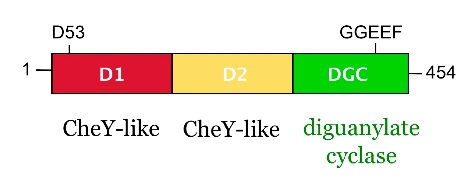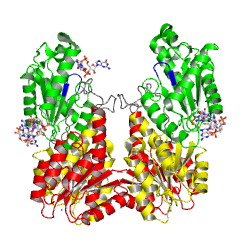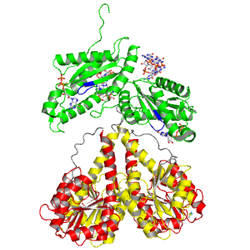User:Tilman Schirmer/Sandbox 201
From Proteopedia
(→Activated conformation) |
(→Intro) |
||
| Line 27: | Line 27: | ||
| - | The motif is part of the <scene name='User:Tilman_Schirmer/Sandbox_201/Substrate_binding_site/4'>substrate binding site</scene> as identified in the structure of PleD in complex with <scene name='User:Tilman_Schirmer/Sandbox_201/Gtp-a-s/1'>GTP-alpha-S / Mg++</scene>. | + | The motif is part of the <scene name='User:Tilman_Schirmer/Sandbox_201/Substrate_binding_site/4'>substrate binding site</scene> as identified in the structure of PleD in complex with <scene name='User:Tilman_Schirmer/Sandbox_201/Gtp-a-s/1'>GTP-alpha-S / Mg++</scene>. For the reaction to proceed, two GTP loaded GGDEF domains have to align antiparallely. MODEL. |
Revision as of 20:58, 20 June 2009
PleD
Contents |
Intro
|
from Caulobacter crescentus is a response regulator with an unorthodox catalytic, diguanylate cyclase, output domain. It is composed of a canonical CheY-like response regulator receiver () domain,
a Rec-like () adaptor domain,
and a C-terminal domain that confers the catalytic acitvity.
The GGDEF domain is named after the highly conserved (in PleD it is GGEEF) that locates to a β-hairpin.
|
The motif is part of the as identified in the structure of PleD in complex with . For the reaction to proceed, two GTP loaded GGDEF domains have to align antiparallely. MODEL.
Allosteric product binding site
|
C-di-GMP
Primary inhibition site (Ip)
Secondary inhibition site (Is)
Primary and secondary inhibition sites
Two conformations
|
|



